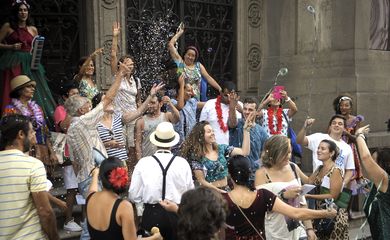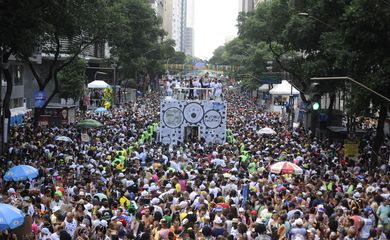Latin Americans party it up at Bésame Mucho


Apart from the classic marchinhas de carnaval—short and often humorous Carnival songs—the repertoire usually includes loads of salsa, cumbia, and funk.

Members of the Latin American community have a favorite stomping ground during Carnival in Rio de Janeiro. Created four years ago, the Bésame Mucho street party is known for bringing together musicians from Mexico, Argentina, Peru, Colombia, and Brazil who live it up with both traditional and new Latin American genres. Apart from the classic marchinhas de carnaval—short and often humorous Carnival songs—the repertoire usually includes loads of salsa, cumbia, and funk. This year, hundreds of revelers met on Sunday (Feb. 7) in Santa Teresa, a district in the downtown area.
Named after Mexican Consuelo Velásquez's eponymous song from the 40's, the bloco, as Carnival street parties are known, was conceived by Ezequiel Soto, also Mexican. He says the idea came to him on his birthday. “It was a way to unite different cultures and party,” he said. The idea came to life soon afterwards.
Today, the bloco can be defined as a group of friends that grows larger by the year. “There are also people from France, Italy, Germany—a veritable babel,” Soto pointed out.
This year, the bloco also saw an increase in its repertoire. Party-goers celebrated to the sound of carimbó, a popular music style from north Brazil. Revelers also danced to Afro Blue, a classic piece by Cuban percussionist Mongo Santa Maria, in addition to other tunes, like the Argentinian Carnavalito (El Humahuaqueno), and the Peruvian Carinito. Lyrics are in Portuguese and Spanish, and sung out by a number of voices, as party-goers move up and down the neighborhood's steep streets.
Among the Brazilian compositions, a carioca funk version of Dorival Caymmi's Suíte dos pescadores was how percussionist Mestre Vitico caught the crowd by surprise. He teaches Latin American percussion throughout the year and plays the new arrangements at the bloco.
Nearly 11 years in Brazil, Mestre Vitico highlights what Latin American styles have in common. “What we usually do is bring Brazilian instruments in, like the surdo, caixa and atabaque drums, and the xequerê rattle, which can now be seen more often in other places, used in arrangements,” he noted.
In his view, Bésame Mucho is a chance to spread Latin American culture and blend in. “I can't really explain. I guess language is perhaps a barrier which keeps Brazil from really knowing the continent. But when we perform, people like it. Our crowd is proof thereof,” he argued.
In Rio for a course on percussion, Mexican physicist Oswaldo Jimenez Farias could not resit. He had played previously at the bloco on a few occasions, but this time it was the conga drum he could not help playing. “Carnival in Rio is one of a kind. That's why we wanted to take place. We're part of the majority of immigrants. This is our chance to be protagonists and join in the fun,” he said.
*Vladimir Platonow, from Agência Brasil, and Nanna Pôssa, from Rádios EBC, contributed to this article.
Translated by Fabrício Ferreira
Fonte: Latin Americans party it up at Bésame Mucho




